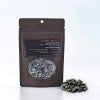
When you come home from the grocery store, do ever notice that—despite having purchased organic food—the plastic bag that the food is in smells like bleach? Well, that’s because there are actually bleach VOCs in the plastic, which in turn leach into your food. When you eat your food, even after it is washed, these VOCs are killing some of your microbiome.
What is the Human Microbiome?
Each person’s microbiome is unique to them, made up of a variety of bacteria, viruses, and fungi microbes—trillions of them. Although these microbes can be found on every surface of the human body, when we refer to our microbiome, we are predominately talking about the community of microbes found in the gut. This is because the largest concentration of microbes is found within the large intestine.
Your microbiome plays a vital role in your experience of health and wellness. For example, the bacteria in your gut aid digestion and metabolism. Some microbes also support a strong immune system and/or healthy reproduction.
How do VOCs harm your food and microbiome?
Volatile organic compounds (VOCs) are special compounds that have a tendency to become vapors or gases (LAHomes.com). Though you may have heard of VOCs in relation to burning gas or coal, they are actually released by a variety of common household products. A few examples include paint thinner, adhesives, glues, air fresheners, pesticides, and cleaning solutions or disinfectants. Bleach is one of the main culprits as it is used everywhere as a standard for disinfecting nearly every manufacturing surface imaginable. Another source of VOCs is the plastic packaging which covers many foods. In the modern food world, VOCs have become almost unavoidable.
VOCs, found in signature fragrances, are designed to attach to anything and everything. So, if your food is in a warehouse and the laundry detergents are within a certain perimeter of the food, then the food and bags will absorb the signature fragrance. When we ingest the exposed food, it damages our good bacteria, leading to imbalance and even inflammation. This condition is linked to a host of ailments such as obesity, inflammatory bowel syndrome, type 2 diabetes, and even cancer. The scary part is that you don’t actually have to consume VOCs for them to get into your bloodstream. They can also enter the body through skin contact or inhalation.
What is the solution?
1. The first step is to avoid VOCs as much as possible. Though not always practical or even possible, you can reduce your food’s exposure by shopping at farmer’s markets. At the traditional market, opt for foods that don’t come wrapped in plastic. If you are feeling proactive, you might also speak to your store manager to inquire about their food storage protocols.
2. When you do shop in a traditional supermarket, avoid VOC contaminated plastics by keeping your food well away from any cleaners. And consider bringing your own organic cloth tote and produce bags. These reusable bags are great for the environment too.
3. At home, opt for cleaners that organic and free of harmful chemicals or fragrances.
4. Wash your hands as soon as possible; wash your produce thoroughly as well. You might also consider a home filtration system to remove VOCs and other toxins from the air.
5. Safeguard against the damage by promoting a strong and healthy microbiome through a well-balanced diet of unprocessed whole foods. Taking a probiotic, eating fermented foods, and avoiding sugar may also encourage good microbes to flourish.
While you may not be able to avoid VOC’s altogether, you can use these five steps to reduce your exposure and safeguard your healthy microbiome. For more personalized guidance on this or any other healing topic, you are invited to schedule a consultation with Rose.
*This blog contains Amazon affiliate links. The owner of this site may receive a small commission if you click a link and make a recommended purchase.
What To Remember:
Every surface of your body hosts a variety of fungi, viruses, and bacteria that make up your microbiome.
VOCs, found in packaging and cleaning products like bleach, can damage your microbiome, causing inflammation and disease.
By avoiding VOCs as much as possible and encouraging healthy microbes to flourish, you can protect your microbiome and your health.
Sources:
Davis, Nathan. (2017). Volatile organic contamination analysis in packaged foods. Retrieved from Iowa State University.
Emory University. (2018). The Microbiome and Cancer. Retrieved from CancerQuest.org.
What Is the Gut Microbiome? (February, 2022). Retrieved from WebMD.com.
Every bite is either fighting disease or creating it.







